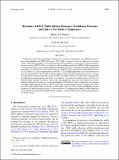Files in this item
Dynamics of ITCZ width : Ekman processes, non-Ekman processes, and links to sea surface temperature
Item metadata
| dc.contributor.author | Byrne, Michael P. | |
| dc.contributor.author | Thomas, Rhidian | |
| dc.date.accessioned | 2019-09-19T15:30:03Z | |
| dc.date.available | 2019-09-19T15:30:03Z | |
| dc.date.issued | 2019-09 | |
| dc.identifier | 261267534 | |
| dc.identifier | 1acbc4d0-711f-413a-8242-3c48e257ee2b | |
| dc.identifier | 000484500800003 | |
| dc.identifier | 85075629715 | |
| dc.identifier.citation | Byrne , M P & Thomas , R 2019 , ' Dynamics of ITCZ width : Ekman processes, non-Ekman processes, and links to sea surface temperature ' , Journal of the Atmospheric Sciences , vol. 76 , no. 9 , pp. 2869-2884 . https://doi.org/10.1175/JAS-D-19-0013.1 | en |
| dc.identifier.issn | 0022-4928 | |
| dc.identifier.other | ORCID: /0000-0001-9019-3915/work/64034814 | |
| dc.identifier.uri | https://hdl.handle.net/10023/18515 | |
| dc.description | This project has received funding from the EU’s Horizon 2020 Research and Innovation Programme under the Marie Skłodowska-Curie Grant Agreement 794063. We also acknowledge support from the Imperial College London Research Fellowship Scheme. | en |
| dc.description.abstract | The dynamical processes controlling the width of the intertropical convergence zone (ITCZ) are investigated using idealized and CMIP5 simulations. ITCZ width is defined in terms of boundary layer vertical velocity. The tropical boundary layer is approximately in Ekman balance, suggesting that wind stress places a strong constraint on ITCZ width. A scaling based on Ekman balance predicts that ITCZ width is proportional to the wind stress and inversely proportional to its meridional gradient. A toy model of an Ekman boundary layer illustrates the effects of wind stress perturbations on ITCZ width. A westerly wind perturbation widens the ITCZ whereas an easterly perturbation narrows the ITCZ. Multiplying the wind stress by a constant factor does not shift the ITCZ edge, but ITCZ width is sensitive to the latitude of maximum wind stress. Scalings based on Ekman balance cannot fully capture the behavior of ITCZ width across simulations, suggesting that non-Ekman dynamical processes need to be accounted for. An alternative scaling based on the full momentum budget explains variations in ITCZ width and highlights the importance of horizontal and vertical momentum advection. Scalings are also introduced linking ITCZ width to surface temperature. An extension to Lindzen-Nigam theory predicts that ITCZ width scales with the latitude where the Laplacian of SST is zero. The supercriticality theory of Emanuel is also invoked to show that ITCZ width is dynamically linked to boundary layer moist entropy gradients. The results establish a dynamical understanding of ITCZ width that can be applied to interpret persistent ITCZ biases in climate models and the response of tropical precipitation to climate change. | |
| dc.format.extent | 16 | |
| dc.format.extent | 1243821 | |
| dc.language.iso | eng | |
| dc.relation.ispartof | Journal of the Atmospheric Sciences | en |
| dc.subject | Tropics | en |
| dc.subject | Atmospheric circulation | en |
| dc.subject | Convergence/divergence | en |
| dc.subject | Hadley circulation | en |
| dc.subject | Momentum | en |
| dc.subject | General circulation models | en |
| dc.subject | QE Geology | en |
| dc.subject | GE Environmental Sciences | en |
| dc.subject | NDAS | en |
| dc.subject | SDG 13 - Climate Action | en |
| dc.subject.lcc | QE | en |
| dc.subject.lcc | GE | en |
| dc.title | Dynamics of ITCZ width : Ekman processes, non-Ekman processes, and links to sea surface temperature | en |
| dc.type | Journal article | en |
| dc.contributor.institution | University of St Andrews. School of Earth & Environmental Sciences | en |
| dc.identifier.doi | https://doi.org/10.1175/JAS-D-19-0013.1 | |
| dc.description.status | Peer reviewed | en |
This item appears in the following Collection(s)
Items in the St Andrews Research Repository are protected by copyright, with all rights reserved, unless otherwise indicated.

